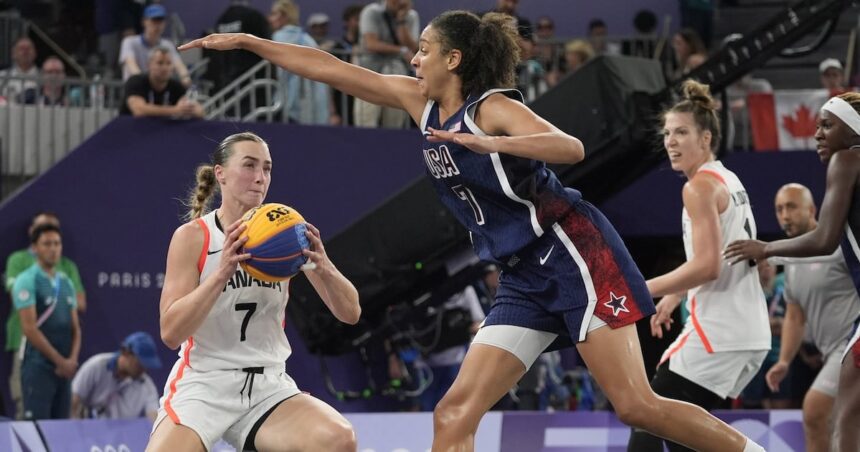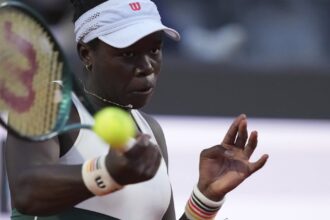In a display of tactical brilliance and sheer determination, Canada’s women’s 3×3 basketball team has secured their spot in the semifinals of the 2025 World Cup after a riveting victory over Spain. The win marks a significant milestone in Canada’s journey in this relatively young Olympic discipline, showcasing our nation’s growing prowess in the fast-paced, street-style variant of traditional basketball.
The Canadian squad, led by their dynamic point guard Michelle Plouffe, demonstrated exceptional court awareness and clutch shooting when it mattered most. The game’s decisive moment came in the final minutes when Plouffe connected on a stunning two-pointer from beyond the arc, silencing the pro-Spanish crowd and effectively sealing the win. This moment wasn’t just about scoring points—it represented the culmination of years of strategic investment in the 3×3 program by Canada Basketball.
“There’s something uniquely Canadian about our approach to 3×3,” remarked team captain Katherine Plouffe in the post-game interview. “We bring that hockey-like grit combined with basketball finesse. On this smaller court, every possession matters, and we’ve embraced that intensity.”
What makes this victory particularly noteworthy is how it reflects the evolution of basketball culture in Canada. Once primarily focused on the traditional 5-on-5 format, our basketball landscape has diversified significantly over the past decade. The success of the Toronto Raptors’ 2019 NBA championship sparked nationwide interest, but the growth of 3×3 represents something different—a grassroots movement that has found its way to international prominence.
The 3×3 format itself deserves attention for how it’s reshaping basketball globally. Played on a half-court with a 12-second shot clock, it demands quick decision-making, versatile skill sets, and extraordinary conditioning. The game’s urban roots have helped it connect with younger demographics, making it one of the fastest-growing team sports worldwide. For many players who might not fit the traditional basketball mold, 3×3 offers a legitimate path to international competition.
Spain, traditionally a formidable opponent in international basketball, brought their characteristic flair and technical prowess to the match. Their quick ball movement and outside shooting kept them competitive throughout, but Canada’s defensive intensity ultimately proved too much to overcome. The Spanish team seemed visibly frustrated by Canada’s physical play—a testament to the evolution of our national approach to the sport.
Looking ahead to the semifinal matchup, Canada will likely face either the United States or France, both powerhouses in the 3×3 format. While the challenge looms large, this Canadian squad has already exceeded expectations. Their journey reflects a larger narrative about Canadian basketball’s rise on the world stage—a story that transcends just sports and speaks to our evolving national identity.
The victory comes at an interesting cultural moment for basketball in Canada. While hockey continues to dominate our national consciousness, basketball has carved out a significant space in our sporting landscape. Cities like Toronto, Montreal, and Vancouver have seen explosive growth in court development, youth programs, and street basketball culture. This grassroots expansion provides the foundation for international success we’re now witnessing.
For those unfamiliar with the 3×3 format, it’s worth noting how the game differs from traditional basketball. Beyond the obvious player count reduction, the sport features a single hoop, continuous play after scores, and a much quicker pace. These elements combine to create a viewing experience that appeals to modern attention spans while maintaining the strategic depth that makes basketball so compelling.
As the Canadian women prepare for their semifinal match, they carry not just their own ambitions but the hopes of a nation increasingly invested in basketball excellence. Their success reminds us how sporting achievement often reflects broader cultural shifts—in this case, Canada’s growing diversity, urban cultural influence, and willingness to embrace non-traditional sporting paths.
Whether they advance to the final or not, this Canadian team has already made a statement on the world stage. Their journey at the 2025 World Cup represents another compelling chapter in Canada’s evolving basketball story—one that continues to be written with each passing tournament and every new generation of players who pick up the game.
For more on Canadian sports achievements and cultural impacts, visit our CO24 Culture section, or explore emerging sports trends at CO24 Trends.


















